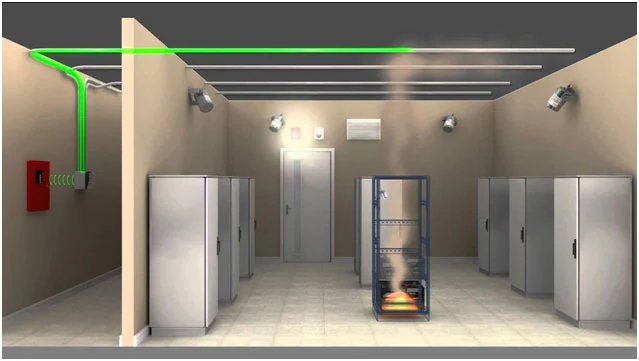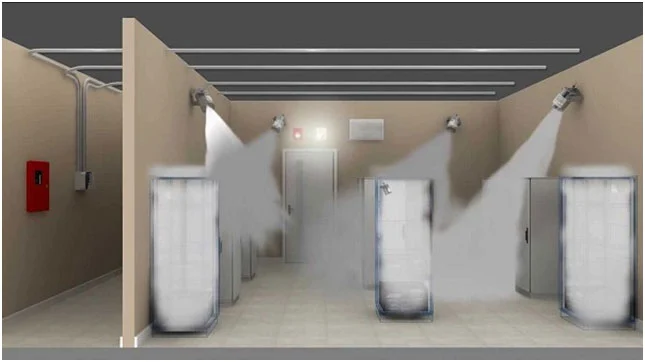- Fire Detection & Alarm System
- Fire Protection System
- HVWS & MVWS System
- Aspiration Detection System (VESDA)
- Linear Heat Sensing Cable
- Public Address System
- Gas Based Suppression System
- Cord / Sticker / Tubed Based Suppression System
- Aerosol Based Suppression System
- Access Control System
- Building Management System
- CCTV System
- Home Automation System
Call Us on 24/7
Contact us at the office nearest to you
033 29725520
Quick Contact
Review of Aerosol Over Other Suppression Systems
- Typical fire extinguishing systems found in commercial and industrial locations include sprinklers, carbon dioxide, clean agent, and dry/wet chemical agents. Another very useful cost effective, hassle free installation and low maintenance fire extinguishing technology available is condensed aerosol. These systems take advantage of the well-established fire suppression capability of solid particulates, with potentially reduced collateral damageassociated with traditional dry chemicals. However, there are some concerns in regard to collateral damage to computers and other sensitive electronic equipment.
- The National Fire Protection Association (NFPA) defines condensed aerosol as an extinguishing medium consisting of finely divided solid particles and gaseous matter, generated by a combustion process of a solid aerosol forming compound. Dry chemical agents are powder based agents that normally range in diameter from 25 to 150 micrometers, while condensed aerosols are defined by NFPA as particles of less than 10 micrometers in diameter. Both produce large surface areas for reaction and are very effective extinguishants.
Construction of Aerosol Generators
- Generally, aerosol generators consist of the casing, initiation device (actuator), aerosol-forming compounds, reaction (oxidation) component, cooling component and discharge ports.
- The solid aerosol generator constructed according to the principal of blast-pipe grinder which reduces the dried product to fine particles by action of jets of compressed fluid (air or nitrogen , for example) in a circular chamber called a micronized.
Content of Aerosol Generators
- The aerosol-generating chemical is a thermoplastic mixture consisting of an oxidizer, a combustible binder and additives. The oxidizer is solid potassium nitrate (KNO3), the binder is solid plasticized nitro-cellulose Chanop) and other ingredients for stabilization.
- Combustion products of the aerosol-generating chemical consists of: potassiumcarbonate (KHCO3, K2CO3), carbon dioxide (CO2), nitrogen (N2) and water (H2O) andrepresent the actual extinguishing agent, completely environmentally friendly.
Action of Generators
(a) Three potential methods of action
(b) Aerosol generation
(c) Aerosol distribution
Working Principle
- The principle of the extinguishing action employed by aerosol is unique – a special solid chemical, which when electrically or thermally ignited, produces combustion byproducts – micron sized dry particles, (mainly potassium
carbonates), and a gaseous mixture, (mainly carbon dioxide, nitrogen and water vapour), mixed together into a uniform fire extinguishing aerosol, before being released into the protected area. The hot aerosol propels itself through a unique solid chemical coolant, which decomposes, absorbing huge amounts of heat, thus ensuring a flameless discharge and a uniform distribution of the cool aerosol within the area. The high rate of aerosol discharge ensures a tremendous knock down effect. Micron sized aerosol particles exhibit gas-like three-dimensional qualities that allow the agent to rapidly distribute throughout enclosure and to reach even the most concealed and shielded locations. Homogenous distribution is achieved in a matter of seconds, while long holding times all help to prevent fire re-ignition.
When activated the solid aerosol element undergoes a combustion reaction, which can schematically be represented as follows:
- KNO3 (s) + CnHmNpOq (s) = KHCO3 (s) + K2CO3 (s) + CO2 (g) + N2(g) + H2O (g)
- Combustion products mainly consist of potassium carbonates (KHCO3 , K2CO3), carbon dioxide gas (CO2 (g)), nitrogen gas ( N2 (g) ) and water vapour (H2O(g)) and represent the actual extinguishing agent.
- As the reaction temperatures are high, potassium carbonates are formed in the gas phase, but as the vapors cools, the potassium carbonates condense to a liquid and then a solid. As solid potassium carbonates are produced by condensation, the particle size is very small – approximately from 1 to 10 microns. Micron sized solid particles mix with the gaseous carbon dioxide, nitrogen and water into a uniform homogeneous gas-like phase – an aerosol.
- Thus, extinguishing aerosol is a suspension of the micron sized solid particles, mainly potassium carbonates, in the gas mix of carbon dioxide, nitrogen and water vapor.
Applications
Aerosols may be used as a fixed fire suppressant system in total flooding (prime application) and localapplications to fight fires of classes A, B, C, E and F. For class C fires consideration should be given tothe use of vapour detection, explosion venting or explosion suppression systems where an explosionpotential may exist, owing to the possible presence of gaseous, volatile or atomized fuels eitherbefore or following a fire. It may be dangerous, under certain conditions to extinguish a burning jet offlammable gases without first shutting off its supply. The design application density required tosuppress normal fires involving flammable gases and liquids at atmospheric pressure shall apply if itcan be shown that a potentially explosive atmosphere cannot exist in the enclosure either before or
as a result of the fire.


